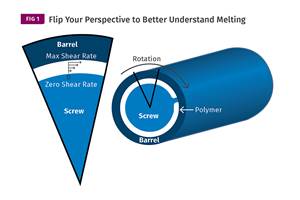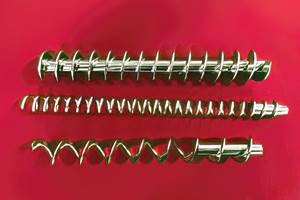Tooling: More Is Better…Layers, That Is
I can’t count the number of times I have been asked why I recommend a blown film line with 5+ layers to make 2- or 3-layer products.
I can’t count the number of times I have been asked why I recommend a blown film line with 5+ layers to make 2- or 3-layer products. The answer is that adding layers to standard (i.e., non-barrier) film boosts the properties and quality of the film, which puts you in a position to charge more for it, and make it for less money, which improves your profitability.
Shortly after joining this industry, I was lucky enough to be employed by a company that was installing a pair of 5-layer blown film lines. The goal was to participate in the growing high-oxygen-barrier (nylon/EVOH) markets. For whatever reason, we were unable to break into the EVOH market in any significant way. So I had two big 5-layer lines to “play with.”
The logical thing to do was to fill these assets with our convential products—moisture-barrier, HDPE-based films, primarily cereal liners and cracker wrap. These products are essentially 2 layers, made mostly on 3-layer lines. But with 5-layer technology at hand, I started to fiddle.
With the additional layers, we were able to use resins to enhance specific properties and not make compromises to get other properties too. Each layer had its mission.
Our new “two-layer” film evolved as follows:
Layer 1: The skin heat-seal layer stayed pretty much the same, except we were able to make it thinner and still have better thickness uniformity. This created a cost savings (these were the most expensive resins in the structure), allowed for some downgauging, and made sealing behavior more consistent.
Layer 2: The application for this film required moisture barrier, so this layer was a HDPE designed for low WVTR (water vapor transmission rate). Such resins often do not process as well as others, and output suffers.
Layer 3: To offset that loss of output, a fractional-melt-index HDPE was used to “stiffen” the tube, so more air could be blown on it. The result: higher throughput rates.
Layer 4: This is where the scrap went. I called it the “sacrificial layer”. This allowed the barrier layers to get the full impact of their barrier properties, and not be polluted by regrind. This presented another opportunity for downgauging.
Layer 5: This layer was made of a high-melt-index barrier HDPE, which could not have been readily used in blown film if there were not other layers in the film to “carry” it.
Our 5-layer equipment allowed the thicknesses of these layers to be manipulated to “dial in” the barrier requirements and cost. Their locations could also be rearranged for the same reasons. Try doing that with a 3-layer line!
At the end of the day we not only had a 5-layer line making a “2-layer” film, we had more output and higher quality and were spending less money to boot. All for a few pennies more a pound in depreciation, much of which was mitigated by the higher outputs.
Once I had 5 layers, I never went back. Neither should you. The additional layers add to the flexibility of the asset. A 3-layer line designed for a 33/34/33 structure, for example, will give you problems if you try to make a 10/80/10 film. With additional layers you can use 2 layers for each skin in the former structure and one extruder for each skin of the latter.
Plus, you may be able to reduce the concentration of your additives in the two skin extruders for more savings. This is because antiblock only affects the surface of the film. The antiblock below the surface is wasted. The slip put in the skin migrates to the surface, and tends to “stick” there, and with a thinner skin, less of it is lost into the core layer. So less of both are needed.
Having a more flexible line also puts you in a better position for the future. In some cases, to get a piece of 大象传媒 for a 3-layer project you might have to go out and purchase a new die, and maybe new extruders. With 5-layer technology you already have that capability.
For example, if you have a 3-layer line designed to run 30/40/30, and your customer wants a 5% heat-seal layer with very uniform thickness, you’ll have little chance of making it on this line without replacing the die, and maybe an extruder screw. With a 5-layer line, you may be able to run this product with one skin extruder.
So what are the negatives of purchasing 5-layer vs. a 3-layer?
- The obvious one is the higher initial capital outlay. This is addressed somewhat by the potential higher output. I like to look at this as a cost/lb of product over the life of the machine. Doing this calculation usually shows that the actual added cost is not that much, especially when compared with other costs. To be driven by lower initial cost is, in my mind, being penny-wise and dollar-foolish.
- The 5-layer die has more steel surface area to clean. This could be partially offset by the fact that layer outputs can be more closely aligned with design conditions, thus keeping the wall shear stresses up so they can keep the walls clean and reduce cleaning frequency.
- There are more extruders to maintain and clean, but they are smaller, and easier to work with.
- The line and the products are more complex. This may require tighter control of your systems and methods.
After being permitted to work in the world of more layers, I get frustrated when forced to have my hands tied with the reduced degrees of freedom imposed by 3-layer lines. We talk a lot about being competitive. Yet so often we do not give ourselves the tools, and degrees of freedom, to be so. A little more money up front can permit you to make so much more money later. As the old saying goes, “Pay me now, or pay me more later.”
About the Author
Eric Hatfield is manager of technology implementation at specialty film processor Clopay Plastic Products, Mason, Ohio. He can be reached at ephatfield@clopay.com.
Related Content
Why Are There No 'Universal' Screws for All Polymers?
There’s a simple answer: Because all plastics are not the same.
Read MorePart 2 Medical Tubing: Use Simulation to Troubleshoot, Optimize Processing & Dies
Simulation can determine whether a die has regions of low shear rate and shear stress on the metal surface where the polymer would ultimately degrade, and can help processors design dies better suited for their projects.
Read MoreUnderstanding Melting in Single-Screw Extruders
You can better visualize the melting process by “flipping” the observation point so the barrel appears to be turning clockwise around a stationary screw.
Read MoreWhat to Know About Your Materials When Choosing a Feeder
Feeder performance is crucial to operating extrusion and compounding lines. And consistent, reliable feeding depends in large part on selecting a feeder compatible with the materials and additives you intend to process. Follow these tips to analyze your feeder requirements.
Read MoreRead Next
People 4.0 – How to Get Buy-In from Your Staff for Industry 4.0 Systems
Implementing a production monitoring system as the foundation of a ‘smart factory’ is about integrating people with new technology as much as it is about integrating machines and computers. Here are tips from a company that has gone through the process.
Read MoreMaking the Circular Economy a Reality
Driven by brand owner demands and new worldwide legislation, the entire supply chain is working toward the shift to circularity, with some evidence the circular economy has already begun.
Read MoreSee Recyclers Close the Loop on Trade Show Production Scrap at NPE2024
A collaboration between show organizer PLASTICS, recycler CPR and size reduction experts WEIMA and Conair recovered and recycled all production scrap at NPE2024.
Read More










